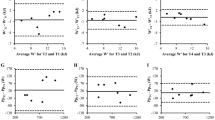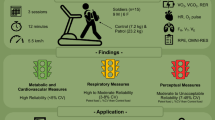Abstract
This study was conducted to measure the reliability of an indoor uphill time trial (TT) using the Velotron electronic bicycle ergometer with a computer-generated pacer that represented a subject’s prior TT performance. A total of 12 trained cyclists (42 ± 7.79 years, 63.0 ± 6.12 ml/kg/min) completed three 8-mile uphill TT with 2–7 days between subsequent tests. A repeated measure ANOVA found no difference between finishing times for TT1 (2,154 ± 246 s) and TT2 (2,078 ± 185 s, p = 0.055) or TT2 and TT3 (2,047 ± 167 s, p = 0.075). All measures of reliability showed an increased reliability for finishing times in TT2–TT3 [95% CI for: coefficient of variation (CV) = 1.0–2.3%, intraclass correlation coefficient (ICC) = 0.953–0.996, standard error of measurement (SEM) = 2.1–4.9 s] versus TT1–TT2 (95% CI for: CV = 2.0–4.9%, ICC = 0.827–0.986, SEM = 9.8–23 s). An uphill TT using the Velotron bicycle ergometer with a prior performance as a pacer is a reliable assessment for indoor TT performance testing, but a familiarization trial improves reliability. Although there were no significant differences found for completion times between TT1–TT2 or TT2–TT3, the absolute mean differences, small sample size and low p values may be suggestive of a Type II error.

Similar content being viewed by others
References
Atkinson G, Nevill AM (1998) Statistical methods for assessing measurement error (reliability) in variables relevant to sports medicine. Sports Med 26:217–238
Balmer J, Davison RC, Coleman DA, Bird SR (2000) The validity of power output recorded during exercise performance tests using a Kingcycle air-braked cycle ergometer when compared with an SRM powermeter. Int J Sports Med 21:195–199
Bishop D (1997) Reliability of a 1-h endurance performance test in trained female cyclists. Med Sci Sports Exerc 29:554–559
Cohen J (1988) Statistical power analysis for the behavioral sciences. Lawrence Earlbaum Associates, Hillsdale
Coyle EF, Feltner ME, Kautz SA, Hamilton MT, Montain SJ, Baylor AM, Abraham LD, Petrek GW (1991) Physiological and biomechanical factors associated with elite endurance cycling performance. Med Sci Sports Exerc 23:93–107
Hickey MS, Costill DL, McConell GK, Widrick JJ, Tanaka H (1992) Day to day variation in time trial cycling performance. Int J Sports Med 13:467–470
Hopkins WG (2000) Measures of reliability in sports medicine and science. Sports Med 30:1–15
Hopkins WG, Hawley JA, Burke LM (1999) Design and analysis of research on sport performance enhancement. Med Sci Sports Exerc 31:472–485
Hopkins WG, Schabort EJ, Hawley JA (2001) Reliability of power in physical performance tests. Sports Med 31:211–234
Jensen K, Johansen L (1998) Reproducibility and validity of physiological parameters measured in cyclists riding on racing bikes placed on a stationary magnetic brake. Scand J Med Sci Sports 8:1–6
Jeukendrup A, Saris WH, Brouns F, Kester AD (1996) A new validated endurance performance test. Med Sci Sports Exerc 28:266–270
Kirkland A, Coleman D, Wiles JD, Hopker J (2008) Validity and reliability of the Ergomopro powermeter. Int J Sports Med 29:913–916
Krebs PS, Powers SK (1989) Reliability of laboratory endurance tests. Med Sci Sports Exerc 21:S10
Laursen PB, Shing CM, Jenkins DG (2003a) Reproducibility of a laboratory-based 40-km cycle time-trial on a stationary wind-trainer in highly trained cyclists. Int J Sports Med 24:481–485
Laursen PB, Shing CM, Jenkins DG (2003b) Reproducibility of the cycling time to exhaustion at VO2peak in highly trained cyclists. Can J Appl Physiol 28:605–615
McLellan TM, Cheung SS, Jacobs I (1995) Variability of time to exhaustion during submaximal exercise. Can J Appl Physiol 20:39–51
Noreen EE, Lemon PW (2006) Reliability of air displacement plethysmography in a large, heterogeneous sample. Med Sci Sports Exerc 38:1505–1509
Palmer GS, Dennis SC, Noakes TD, Hawley JA (1996) Assessment of the reproducibility of performance testing on an air-braked cycle ergometer. Int J Sports Med 17:293–298
Paton CD, Hopkins WG (2006) Ergometer error and biological variation in power output in a performance test with three cycle ergometers. Int J Sports Med 27:444–447
Schabort EJ, Hawley JA, Hopkins WG, Mujika I, Noakes TD (1998) A new reliable laboratory test of endurance performance for road cyclists. Med Sci Sports Exerc 30:1744–1750
Smith MF, Davison RC, Balmer J, Bird SR (2001) Reliability of mean power recorded during indoor and outdoor self-paced 40 km cycling time-trials. Int J Sports Med 22:270–274
Sporer BC, McKenzie DC (2007) Reproducibility of a laboratory based 20-km time trial evaluation in competitive cyclists using the Velotron Pro ergometer. Int J Sports Med 28:940–944
Weir JP (2005) Quantifying test-retest reliability using the intraclass correlation coefficient and the SEM. J Strength Cond Res 19:231–240
Zavorsky GS, Murias JM, Gow J, Kim DJ, Poulin-Harnois C, Kubow S, Lands LC (2007) Laboratory 20-km cycle time trial reproducibility. Int J Sports Med 28:743–748
Author information
Authors and Affiliations
Corresponding author
Additional information
Communicated by Susan Ward.
Rights and permissions
About this article
Cite this article
Noreen, E.E., Yamamoto, K. & Clair, K. The reliability of a simulated uphill time trial using the Velotron electronic bicycle ergometer. Eur J Appl Physiol 110, 499–506 (2010). https://doi.org/10.1007/s00421-010-1501-z
Accepted:
Published:
Issue Date:
DOI: https://doi.org/10.1007/s00421-010-1501-z




